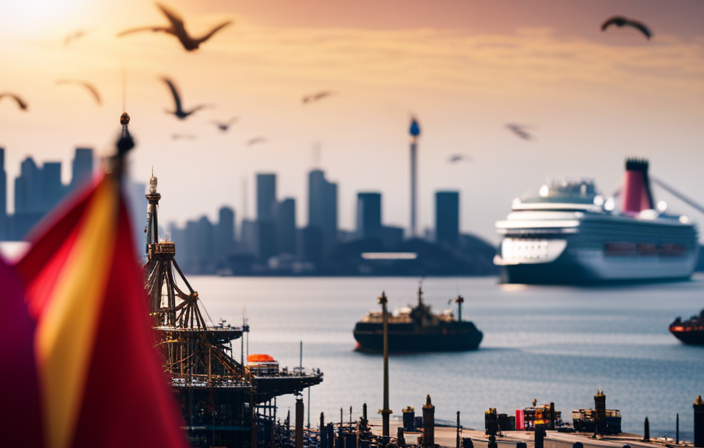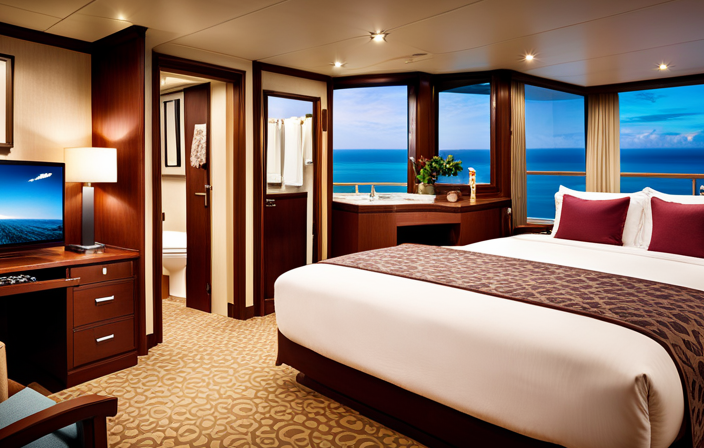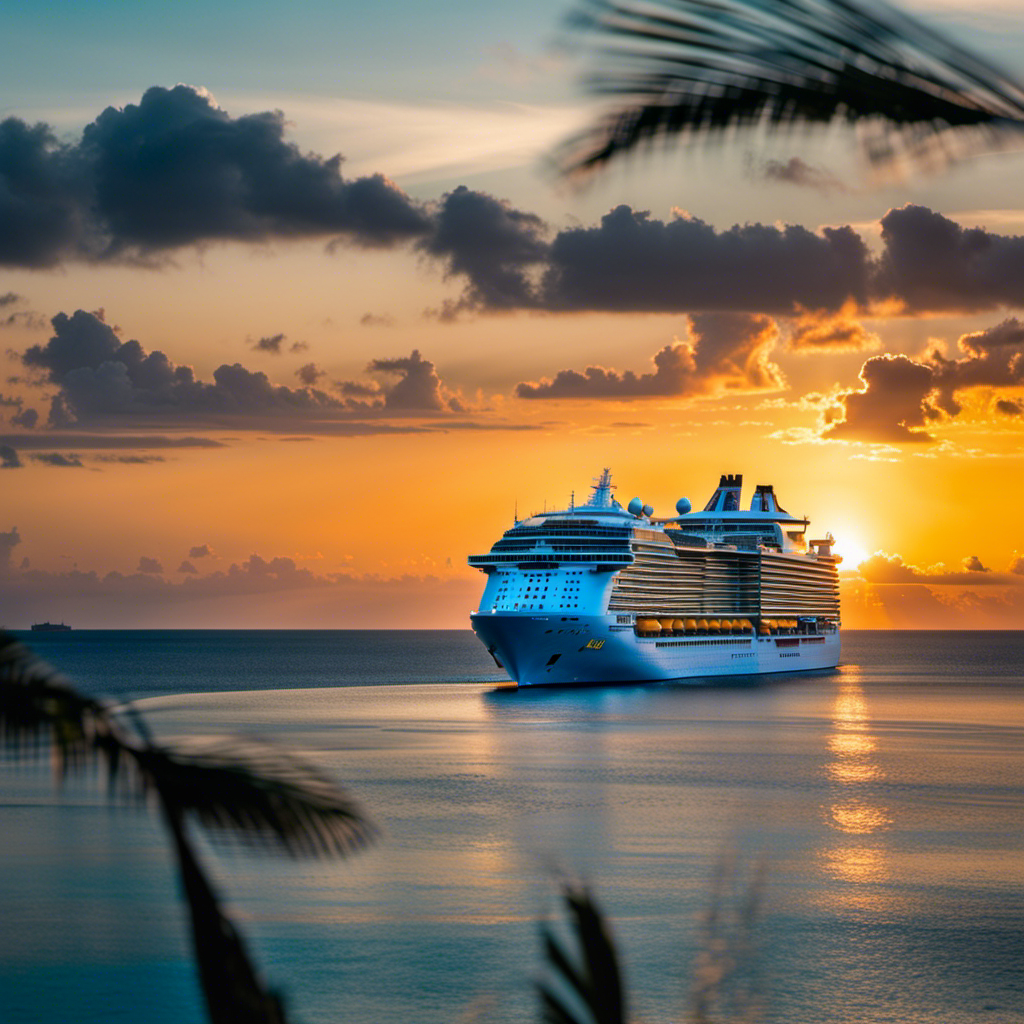Have you ever thought about the total cost of port fees on a cruise? My own experiences have shown that they can be quite surprising. When I began planning my cruise getaway, I was completely unaware of these fees and how expensive they could end up being. However, as I continued to plan, it became evident that knowing and budgeting for port fees is crucial when preparing for a trip.
In this article, we will explore everything you need to know about port fees on a cruise. From factors influencing their cost to calculating them for different destinations, we will cover it all. We will also discuss additional charges and taxes that may be incurred during your trip. Plus, I’ll share some tips on how to save money on port fees and debunk common misconceptions surrounding them.
So if you’re ready to navigate the murky waters of port fees and ensure a smooth sailing experience, let’s dive in!
Key Takeaways
- Allocating funds specifically for port fees is important to avoid financial stress and scrambling for extra money.
- Taking advantage of package deals that include port fees can help save money and simplify the budgeting process.
- It’s essential to be prepared for unexpected fee increases and consider alternative options to save money during shore excursions.
- Planning for unexpected fees by setting aside extra cash in the budget and having a contingency fund is crucial to be financially prepared.
Understanding Port Fees on a Cruise
Understanding the breakdown of port fees on a cruise is important because they can vary depending on the specific ports of call and the length of your trip. Port fees are an essential part of cruise pricing, and calculating these costs is crucial for budgeting purposes.
These fees typically cover various expenses related to docking and using the facilities at each port. They can include things like harbor dues, pilotage fees, wharfage charges, and passenger taxes.
The total amount you pay in port fees will depend on how many ports you visit during your cruise and how long you spend at each one. Understanding the impact that these fees have on cruise pricing will help you plan your budget accordingly.
Now let’s explore some factors that influence the cost of port fees.
Factors Influencing the Cost of Port Fees
Visiting different destinations during your voyage can significantly impact the overall price tag, with some ports charging fees that are surprisingly higher than others. Factors affecting port fee rates include the popularity and demand of the destination, the size of the cruise ship, and the services and amenities provided by the port. Additionally, government regulations and taxes also play a role in determining port fees.
The impact of these fees on cruise prices can vary greatly depending on the itinerary and length of your trip. For example:
- Popular tourist destinations may have higher port fees due to increased demand.
- Larger cruise ships may incur higher fees because they require more space and resources at each port.
- Ports that offer additional services such as transportation or guided tours may charge extra fees.
- Some countries impose higher taxes or customs duties on cruise ships.
Considering these factors is crucial when planning a cruise to understand how port fees will affect your overall budget.
Transitioning into calculating port fees for different destinations, it’s important to take into account various variables that contribute to the final cost.
Calculating Port Fees for Different Destinations
When planning your voyage, it’s exciting to explore the diverse range of destinations and calculate the costs associated with port fees for each unique location.
Calculating fees for popular cruise destinations can vary depending on factors such as the size of the ship, duration of stay, and local regulations.
For instance, in the Caribbean, port fees can range from $10 to $30 per passenger.
In Alaska, port fees are typically higher due to remote locations and environmental considerations, averaging around $100 per passenger.
European ports often charge between $5 and $15 per passenger.
These calculations are crucial when budgeting for your trip and understanding the overall cost of cruising.
Now that we’ve covered calculating port fees for different destinations, let’s delve into additional charges and taxes involved in a cruise vacation.
Additional Charges and Taxes
Get ready to experience a whole new level of excitement as we explore the additional charges and taxes that come along with your incredible cruise vacation. Understanding cruise line fees is essential for planning your budget effectively.
In addition to the base fare, there are various charges you need to be aware of, such as gratuities, service fees, and onboard purchases. These fees can add up quickly, so it’s important to factor them into your overall expenses.
Another aspect to consider is the impact of exchange rates on port fees. If you’re sailing internationally, fluctuations in currency values can affect the amount you pay for port fees. It’s worth keeping an eye on exchange rates beforehand to have a better understanding of how they might impact your final bill.
Now that you understand the additional charges and potential currency considerations, let’s move on to some tips for saving on port fees without compromising your unforgettable cruise experience.
Tips for Saving on Port Fees
One way to cut down on expenses is by taking advantage of special promotions and discounts offered by the cruise line. By keeping an eye out for these savings strategies, you can significantly reduce your port fees. Here are a few cost cutting measures to consider:
| Strategy | Description |
|---|---|
| Booking early | Many cruise lines offer early booking discounts, allowing you to secure a lower rate on your port fees. |
| Off-peak travel | Traveling during less popular times can often result in lower port fees due to decreased demand. |
| Group bookings | Some cruise lines offer group discounts, so gather your friends or family members for additional savings on port fees. |
By implementing these tips, you can save money on your overall cruise costs and have more funds available for other aspects of your vacation. Understanding the value of port fees is essential in making informed decisions about how much you’re willing to spend on them without compromising the quality of your trip.
Understanding the Value of Port Fees
Understanding the worth of these charges is crucial in making informed decisions about how to allocate your vacation budget. When calculating port fees, it is important to consider what you are getting in return.
Port fees cover a variety of expenses such as docking, maintenance, and security services provided by the port authorities. These fees also contribute to local economies, supporting jobs and infrastructure development in the surrounding areas.
Comparing port fees can help you determine which destinations offer better value for your money. Some ports may have higher fees but provide additional amenities and attractions that make them worthwhile.
By understanding the value of port fees, you can prioritize destinations that align with your interests and preferences while still staying within your budget.
Moving on to common misconceptions about port fees…
Common Misconceptions about Port Fees
Don’t be fooled by common misconceptions surrounding port fees – they’re not just another unnecessary expense, but rather an investment in local economies and a gateway to exciting attractions.
One of the biggest misconceptions is that port fees are hidden charges that cruise lines sneak into your bill. In reality, these fees are transparently disclosed upfront and cover the cost of using the facilities at each port.
The fees go towards maintaining and improving ports, supporting local businesses, and preserving the environment. Additionally, port fees allow you to explore fascinating destinations and experience unique shore excursions.
Planning for port fees in your cruise budget is essential to ensure you can fully enjoy all the incredible opportunities each destination has to offer. So don’t underestimate the value of these fees – they provide access to unforgettable experiences during your cruise adventure!
Planning for Port Fees in Your Cruise Budget
When budgeting for your cruise adventure, it’s important to factor in the costs of port fees. Port fees are an essential part of your cruise budget, and planning ahead can help you avoid any surprises. Here are some tips to help you navigate these hidden costs:
-
Research in advance: Take the time to check the port fees for each destination on your itinerary. Including them in your overall budget will give you a clearer picture of your expenses.
-
Set aside extra funds: Allocate a portion of your budget specifically for port fees. By doing so, you’ll be prepared when it’s time to pay and won’t have to scramble for extra money.
-
Look for package deals: Some cruise lines offer packages that include port fees. Taking advantage of these deals can help you save money and simplify your budgeting process.
By incorporating these tips into your budgeting strategy, you’ll be well-prepared for any unexpected increases in port fees. In the next section, we’ll discuss tips for dealing with those unexpected changes.
Tips for Dealing with Unexpected Port Fee Increases
Prepare yourself for any surprise increases in port fees by being aware of alternative options that can help you save money during your shore excursions. Dealing with unexpected fees can be frustrating, but there are ways to manage budget constraints.
First, consider booking your shore excursions independently instead of through the cruise line. This can often save you money and give you more flexibility in choosing activities.
Additionally, research local transportation options such as public buses or taxis instead of relying on expensive cruise line transfers.
Another tip is to pack a picnic lunch or snacks for your day ashore instead of dining at pricey restaurants.
Finally, be sure to set aside some extra cash in your budget specifically for unexpected fees so that you’re prepared if they arise.
By following these tips, you’ll be better equipped to handle any surprises and make the most of your cruise experience without breaking the bank.
In conclusion and final thoughts on port fees, it’s important to remember that while they may seem like an additional cost, they are necessary for maintaining the ports and providing essential services for cruisers. By understanding these fees and planning accordingly, you can ensure a smooth sailing experience without any financial surprises along the way.
Conclusion and Final Thoughts on Port Fees
To wrap things up, let’s take a moment to reflect on the importance of understanding and planning for these necessary expenses, ensuring that your voyage remains smooth sailing from start to finish.
Final thoughts on port fees are crucial for any cruiser. These fees may seem like an additional burden, but they play a significant role in maintaining and improving the ports you visit. They help cover maintenance costs, security measures, and infrastructure upgrades, ultimately enhancing your overall experience.
By acknowledging their importance and including them in your budget, you can avoid any unexpected surprises during your trip. Remember to research and compare different cruise lines to find the best deals on port fees.
Being aware of these costs will allow you to plan accordingly and fully enjoy every destination along your journey.
Frequently Asked Questions
Are port fees the same for all cruise destinations?
Port fees vary depending on the cruise destination. Popular cruise destinations like the Caribbean and Alaska may have higher port fees due to their popularity and demand. These fees can impact the affordability of a cruise, so it’s important to consider them when planning your trip.
Are port fees included in the initial cost of a cruise ticket?
Port fees, an unavoidable expense, are typically not included in the initial cost of a cruise ticket. They cover various services at ports such as docking, security, and maintenance. Understanding their impact is crucial to accurately budgeting for your overall cruise expenses.
How often do port fees increase and by how much?
Port fees on a cruise can increase due to factors like inflation, maintenance costs, and government regulations. The average increase varies across cruise lines, with some raising fees annually while others do so less frequently.
Are there any exemptions or discounts on port fees for certain passengers?
Certain passengers may be eligible for exemptions or discounts on port fees. Eligibility criteria vary, but examples include senior citizens, military personnel, and loyalty program members. These benefits provide savings and enhance the overall cruise experience.
Can port fees be paid in advance or only on the day of the cruise?
Port fees can be paid in advance or on the day of the cruise. It’s convenient to pay beforehand to avoid any last-minute hassles. As for refunds, check with the cruise line for their specific port fees refund policy.
Can Cruise Port Fees Affect the Overall Cost of Excursions?
When planning a cruise, it’s important to consider how cruise port fees can impact the overall cruise excursion cost information. These fees can vary depending on the port and may result in higher excursion costs for passengers. It’s crucial to factor in these fees when budgeting for shore excursions.
Conclusion
In conclusion, understanding and planning for port fees is an essential part of budgeting for a cruise. These fees can vary depending on the destination and factors such as the size of the ship and length of stay at each port.
One interesting statistic to consider is that, on average, port fees can account for up to 20% of the total cost of a cruise. This staggering figure highlights the importance of factoring in these fees when planning your dream vacation at sea.
So, be sure to research and budget accordingly to make the most out of your cruise experience!










